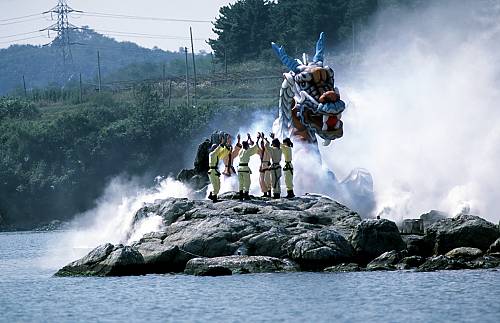Cheoyongmu
Inscribed in 2009 (4.COM) on the Representative List of the Intangible Cultural Heritage of Humanity
Country(ies): Republic of Korea
Identification
Description

- Cheoyongmu
- © 2000 by Cultural Heritage Administration
Cheoyongmu is a court dance today performed on stage but formerly used to dispel evil spirits and pray for tranquillity at royal banquets or during exorcism rites on New Year’s Eve to promote good fortune. Based on the Korean legend of Cheoyong, a son of the dragon king Yongwang, who took human form and saved his human wife from the smallpox spirit through singing and dancing, the dance is performed by five men clad in white, blue, black, red and yellow to represent the four cardinal directions and the centre. They wear the light wine-coloured mask of the man-god, with white teeth, tin earrings with a necklace of lead beads, and a black hat decorated with two peony blossoms and seven peaches to ward off evil and invite auspicious energy. The dancers move with stateliness and vigour through a variety of styles and tempos of music, punctuated by various lyrical song recitations. Part of a greater folk mythology surrounding Cheoyong, including the belief that his image carved on the gate of a house would repel smallpox and other ills, Cheoyongmu also embodies the philosophy of Confucianism, particularly the Theory of the Five Elements. The creation of the Cheoyong masks also provides a valuable opportunity for traditional craftsmanship.
Documents
Decision 4.COM 13.64
The Committee (…) decides that [this element] satisfies the criteria for inscription on the Representative List of the Intangible Cultural Heritage of Humanity, as follows:
- R.1: Cheoyongmu is an art form that is recognized and upheld by its practitioners as a marker of their identity, one that they have endeavoured to hand down from generation to generation;
- R.2: Inscription on the Representative List will make the element better known to artists and scholars, giving wider visibility to intangible cultural heritage, both to an international audience and within the community of practitioners;
- R.3: A series of safeguarding measures demonstrates the will and commitment of the State and community to safeguard the element, providing financial and other support to ensure favourable conditions for its transmission and viability;
- R.4: The element has been nominated with active involvement of the community and, in particular, the tradition bearers who have given their free, prior and informed consent in writing;
- R.5: The element is designated as Important Intangible Cultural Heritage by the Intangible Cultural Heritage Division of the Cultural Heritage Administration.
Slideshow
Video
These videos (and many more) can also be consulted through the UNESCO Archives Multimedia website











